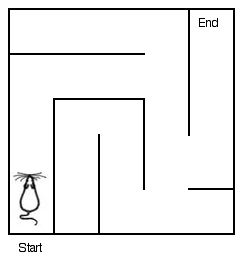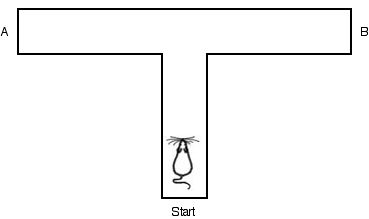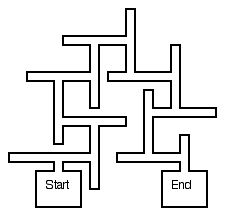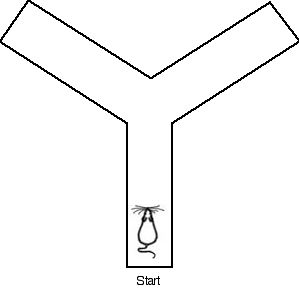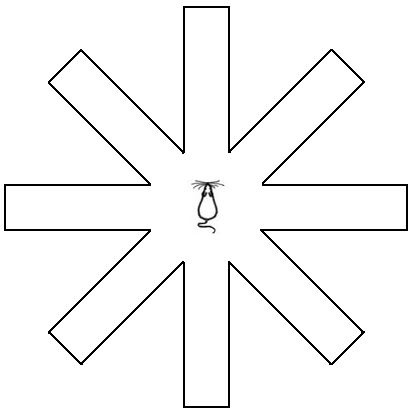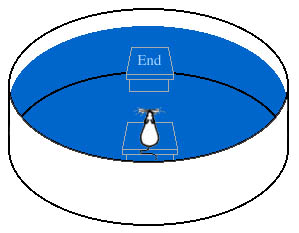Different types of mazes and what they're used for
Rats have been used in experimental mazes since at least the early 20th century. Thousands of studies have examined how rats run different types of mazes, from T-mazes to radial arm mazes to water mazes. These maze studies are used to study spatial learning and memory in rats. Maze studies helped uncover general principles about learning that can be applied to many species, including humans. Today, mazes are used to determine whether different treatments or conditions affect learning and memory in rats.
Rats are particularly gifted at running mazes. Their maze-running ability comes from their evolutionary history: rats are small burrowing rodents that have spent millenia digging and finding their way around underground tunnels. It's no wonder they have a knack with mazes.
The Classic maze
|
|
How many trials does it take for a hungry rat to run the maze to the food reward at the end with no mistakes? How
quickly does the rat complete the maze each time? Does the rat get faster over multiple trials? Over time, rats tend
to run the maze with fewer and fewer errors, more and more quickly. By graphing the number of errors over time, you
can generate a learning curve for the rats.
|
Fun projects Mazes look pretty simple to us. After all, we humans have a top-down view and can easily spot the solution of a small maze like the one pictured above. But a rat down in the maze can't see the whole thing: he can only see the corridors in front, behind, and to either side of him. The solution is not obvious at all! To experience what a maze might be like for a rat, try the projects below:
|
The T-maze
|
|
What kinds of questions can you answer with a T-maze?
Side preferences: The simplest question one can ask in a T-maze is whether a rat has a natural side preference. With no reward in either arm, does a rat prefer to go right or left?
Alternation: You can study natural alternation by running a rat in a T-maze over multiple trials with no reward. Do rats alternate between left and right arms? You can also train rats to alternate by rewarding first one arm, then the other, over many trials. The rat should learn to choose the arm that was not visited on the previous trial.
Learning: T-mazes are also used to study simple learning. You can place a reward at the end of one of the arms, then run a hungry rat through the maze multiple times. How many trials does it take before the rat chooses the correct arm most of the time? Further, if the reward is removed, and the rat is run through the maze multiple times, for how many trials does the rat continue to prefer the now empty arm? If the reward is replaced, how many trials does it take for the rat to re-establish a preference for that arm?
Preference: T-mazes are used to ask rats to choose between two options. A different reward is placed in each arm of the maze. Rewards can be anything: different foods, another rat in a small cage, shelter, an odor. The rat is allowed to explore the whole maze. Then the rat is placed in the start location, and the researcher records the rat's choice: for example, the amount of time the rat spends at the end of each arm over a period of time (say, 5 minutes). You can ask the rat all sorts of questions, like:
- Whether a rat prefers chocolate cake to peas
- Whether a rat prefers familiar-smelling bedding to fresh, unsoiled bedding
- Whether a female rat in heat prefers one male rat or another
- Whether a male rat prefers a strange or familiar female
- Whether a young rat prefers an adult male or an adult female
- Whether a rat prefers to eat food from a bowl other rats have already visited, or identical food from a new, clean bowl.
The Multiple T-maze
|
|
What kinds of questions can you ask with a multiple T-maze?
Multiple T-mazes were used to answer questions of place vs. response learning and cognitive maps.
Cognitive maps and latent learning: do rats learn a maze by choosing the corridors that lead to a reward, or do they generate an internal map of the maze even without a reward (called latent learning)? To answer this question, researchers placed a rat in a maze and let it explore the maze with no reward. The rat simply wandered about. Then the researchers started placing food in the reward corner. Rats who were already familiar with the maze learned to solve the maze more quickly and acheived better scores than rats who had never been given exploration time. Their proficiency indicated that the rats had generated a cognitive map of the maze during their explorations (Tolman and Honzik 1930).
Place learning vs. response learning: Do rats solve the maze by learning that the goal box is in a particular place in space, relative to cues outside the maze? For example, they might learn to go toward the place closest to the room's window or under an overhead lamp. This is called place learning, and is the chief form of learning in cognitive map theory. Alternatively, rats might learn a particular response to a maze, like 'left, right, left, left, right.' This is called response learning and belongs to stimulus-response theory. In this theory, rats choose to go left or right depending on which choice led them to the food in previous trials. The food reward reinforces the correct choices.
So, do rats use place learning or response learning? This question was tested by letting rats familiarize themselves with a maze. After a certain number of trials, the whole maze was rotated in the room. How well the rats performed after the rotation depended on (1) how many external cues were available, and (2) how many practice runs the rats got ahead of time. If rats were given lots of external cues (windows, overhead lamps, a clock on the wall) and ran the maze only a handful of times before testing, then they used place learning and made choices that brought them to the place in the room where the food reward was usually located. However, if external cues were few, and rats ran the maze hundreds of times before testing, then they used response learning. They consistently chose the same path regardless of how the maze was rotated (see Malone 1991 for more).
The Y-maze
|
|
What kinds of questions can you answer with a Y-maze?
Y-mazes can be used to ask all the same questions as T-mazes. For example:
Alternation: if rats are left in the Y-maze for 5 minutes, how do they explore it? Do they explore each arm in turn? Do they remember which arm they entered last?
Novelty and memory: Do rats prefer to spend time in new or known areas? To test this, one arm of the Y-maze is blocked off and the rat is allowed to explore the other two arms for about 15 minutes. Then the rat is placed in the start arm and the blocked arm is uncovered. Does the rat prefer the new arm or the known one? To test the rat's memory there might be a delay of several hours between the familiariazation phase and the test phase. The rats' memory function might then be tested under different conditions, like under the influence of drugs that may inpair or enhance memory.
The most interesting Y-maze I've ever seen was a giant underwater Y-maze used to test preferences in sharks!
The radial arm maze
|
|
What kinds of questions can you answer with a radial arm maze?
Short-term memory: Do rats remember which arms of the maze they've already visited? To test this, a single food pellet is placed at the end of each arm. A rat is placed on the central platform. The rat visits each arm and eats the pellet. To successfully complete the maze, the rat must go down each arm only once. He must use short-term memory and spatial cues to remember which arms he's already visited. If a rat goes down an arm twice, this counts as an error. The rat's performance on the maze is considered a test of short-term memory. Short-term memory can then be tested in different rats or under different treatment conditions. For example, do males perform better than females? What about young vs. old rats?
Behavioral neuroscience: The rats might be given particular drugs (like alcohol) to see if these impair or
enhance short-term memory. Different brain areas might also be impaired to see how important they are in short-term
memory tasks.
The Morris water maze
|
|
What kinds of questions can you answer with a Morris water maze?
Spatial learning, place learning, cognitive maps and memory: How many trials does it take for the rat to locate the hidden platform? What kinds of spatial cues does a rat use to find the hidden platform? What happens if these cues are changed or moved?
Behavioral neuroscience: What parts of the brain are used for spatial learning and memory? The Morris water maze is very popular for studies of behavioral neuroscience (D'Hooge and De Deyn 2001). For example, how does a trained rat's performance change after manipulation of different parts of its brain, like the hippocampus (e.g. Burwell et al. 2004, Harker and Whishaw 2004)? How does performance change after a rat receives certain drugs or enzymes (e.g. Dash et al. 2004)? How well do different strains of rats perform?
